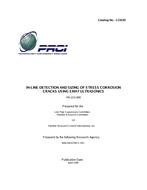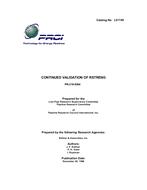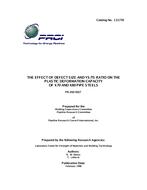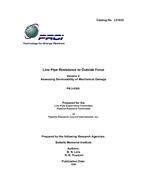Provide PDF Format
PRCI PR-155-909
- In-Line Detection and Sizing of Stress Corrosion Cracks Using EMAT Ultrasonics
- Report / Survey by Pipeline Research Council International, 04/01/1990
- Publisher: PRCI
$125.00$249.00
L51630e
Magnasonics Inc.
Need: The development of stress corrosion cracks (SCC) in buried gas pipelines
has posed a serious threat to pipeline integrity for many years. It can be reliably detected by magnetic particle techniques in the field or by laboratory studies using low frequency eddy currents. It is also possible to find and measure the depths of the cracks from the ID by careful scanning with an ultra-sonic angle beam probe but the transducer must be manipulated by a skilled operator. All of these approaches are not very satisfactory for in-line in-spections because they are not suitable for covering the total area of a pipeline and they are too labor intensive to be automated. In order to address this problem with new technology, the PRCI requested proposals for any technique that seemed to be practical and the Electromagnetic Acoustic Transducer (EMAT) was suggested as very promising because it has already demonstrated operation in the environment of the inside of a gas pipeline. Magnasonics, Inc., of Albuquerque, New Mexico, was chosen from many respondents to conduct an in-vestigation of the use of EMATs for overcoming the problems expected to arise from in-line operation and to incorporate the latest developments in ultrasonic inspection with EMATs.
Benefit: The objective of the program described in this report was twofold. First, to apply the most recent developments in EMAT technology to the problem of detecting and sizing stress corrosion cracks (SCC) in operating gas pipelines and second to exploit the ability of EMATs to generate and detect a wide variety of ultrasonic waves in the walls of a pipeline under operating conditions.
Result: To achieve these objectives, the PRCI provided Magnasonics with four coupons cut from pipe that contained colonies of SCC and one complete pipe 24" in diameter and 8' long containing one isolated colony of cracks near its center and away from the weld line. Magnasonics assembled a variety of EMATs capable of inspecting these samples with various kinds of ultrasonic waves at several frequencies in the 100 kHz to 3 MHz range. Electronic transmitters and preamplifiers specifically designed for these transducers were assembled and computer programs were written to extract as much information as possible from the ultrasonic signals produced by these EMATs. By the end of the program, a mechanical scanning device had been constructed to scan an EMAT sensor past the SCC colony in the 8' pipe while a personal computer printed out graphs of several properties of the ultrasonic signals that had interacted with the flaws in the pipe.
Magnasonics Inc.
Need: The development of stress corrosion cracks (SCC) in buried gas pipelines
has posed a serious threat to pipeline integrity for many years. It can be reliably detected by magnetic particle techniques in the field or by laboratory studies using low frequency eddy currents. It is also possible to find and measure the depths of the cracks from the ID by careful scanning with an ultra-sonic angle beam probe but the transducer must be manipulated by a skilled operator. All of these approaches are not very satisfactory for in-line in-spections because they are not suitable for covering the total area of a pipeline and they are too labor intensive to be automated. In order to address this problem with new technology, the PRCI requested proposals for any technique that seemed to be practical and the Electromagnetic Acoustic Transducer (EMAT) was suggested as very promising because it has already demonstrated operation in the environment of the inside of a gas pipeline. Magnasonics, Inc., of Albuquerque, New Mexico, was chosen from many respondents to conduct an in-vestigation of the use of EMATs for overcoming the problems expected to arise from in-line operation and to incorporate the latest developments in ultrasonic inspection with EMATs.
Benefit: The objective of the program described in this report was twofold. First, to apply the most recent developments in EMAT technology to the problem of detecting and sizing stress corrosion cracks (SCC) in operating gas pipelines and second to exploit the ability of EMATs to generate and detect a wide variety of ultrasonic waves in the walls of a pipeline under operating conditions.
Result: To achieve these objectives, the PRCI provided Magnasonics with four coupons cut from pipe that contained colonies of SCC and one complete pipe 24" in diameter and 8' long containing one isolated colony of cracks near its center and away from the weld line. Magnasonics assembled a variety of EMATs capable of inspecting these samples with various kinds of ultrasonic waves at several frequencies in the 100 kHz to 3 MHz range. Electronic transmitters and preamplifiers specifically designed for these transducers were assembled and computer programs were written to extract as much information as possible from the ultrasonic signals produced by these EMATs. By the end of the program, a mechanical scanning device had been constructed to scan an EMAT sensor past the SCC colony in the 8' pipe while a personal computer printed out graphs of several properties of the ultrasonic signals that had interacted with the flaws in the pipe.
Related Products
PRCI PR-202-9327
Effect of Defect Size and YS/TS Ratio on the Plastic Deformation Capacity of X70 and X80 Pipe Steels..
$198.00 $395.00
PRCI PR-003-9305
Line Pipe Resistance to Outside Force: Assessing Serviceability of Mechanical Damage..
$298.00 $595.00





